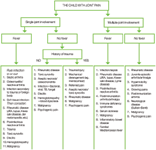The child with joint pain
Review of musculoskeletal complaints in children and diagnostic approach to dealing with joint pain.
Where are they now?
Earl J. Brewer Jr, MD, is retired but still helps out at the CARRA program, a part of NCI, and he is on the Board of the Friends of the Texas Medical Center Library and the Kelsey Research Foundation. Abraham Gedalia, MD, is Professor of Pediatric Rheumatology, LSU Health Sciences, NewCenter and Children's Hospital, New Orleans.
The years 2000 to 2010 are designated by the World Health Organization and the United Nations as the Bone and Joint Decade, to stimulate research to advance the diagnosis and treatment of musculoskeletal conditions.
In a busy pediatric practice, musculoskeletal complaints are estimated to account for about 3% of office visits. The differential diagnosis of joint or limb pain is broad and complex. Although many causes are self-limited and benign like "growing pains," other cases are due to severe and dangerous diseases like bacterial septic arthritis. Some are the result of readily apparent events like trauma or overuse, while some are due to serious occult systemic disease like leukemia or lupus. That complexity presents the busy pediatrician with a real diagnostic challenge and can lead to a random, haphazard, and overly expensive approach to solving the problem.

After getting the answers to the three questions suggested in the Brewer and Gedalia algorithm, today's busy practitioner needs to be able to do an efficient musculoskeletal screening exam. For school-aged children, the GALS screen (Gait, Arms, Legs, Spine) has demonstrated excellent validity and can be performed in only 1.5 to three minutes. An excellent review of the GALS screen, complete with illustrations demonstrating the specific maneuvers, was published in 2006.2
Although the diagnostic approach suggested by Brewer and Gedalia is as useful today as it was 25 years ago, the prevalence of some of the more acute causes of joint pain have changed dramatically. For example, Lyme disease was first recognized as a cause of joint disease in children in the mid-1970s.
Since then, the Centers for Disease Control and Prevention have reported a rapid increase in its incidence during the 1980s, and a further doubling in the 1990s. In contrast, the incidence and prevalence of septic arthritis due to S pneumococcus and H influenzae have fallen dramatically thanks to effective vaccines for these invasive bacterial infections. (Septic arthritis is still the "diagnosis you never want to miss.") Moreover, methicillin-resistant Staphylococcus aurens (MRSA) and Kingella kingae are increasingly frequent causes of joint infections in children.
The prevalence of the rheumatologic diseases of childhood have probably not changed dramatically in the past 25 years. However, what used to be identified as juvenile rheumatoid arthritis (JRA) with its three subtypes, is now encompassed within the disease group of juvenile idiopathic arthritis (JIA), with seven distinct categories.3,4 This reclassification was to ensure as much homogeneity as possible within each subtype, to facilitate communication and clinical research on etiology and treatment, and improve patient care.